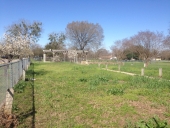The best way to accomplish your goal is to deep mulch in the fall to start, deep leaves to insulate the ground so the frost doesn't go as deep until the snow has enough depth to insulate .
In the spring you want to make a solar collector. Dark colour covered by a transparent sheet. Go ahead and spread your grounds (or ashes, or
compost) on the snow but then cover that with plastic sheet. Once the snow is melted you probably want to pull your mulch back to expose the soil to the sun and replace the sheet.
This will give you the best heat gain during the day.
You'll still loose the heat at night unless your cover has better insulation like old windows or you cover with some sort of insulating blanket at night.
Plant and pull the mulch back a month or two later when you're trying to reduce evaporation from the soil.






